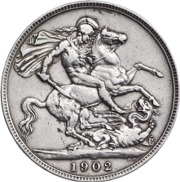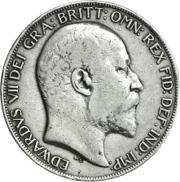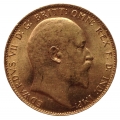 The 1902 Crown
The 1902 Crown1902 Edward VII Crown. Reverse shows George and the Dragon.
Obverse is bare head of King Edward VII, designed by G W DeSaulles (1862-1903). The initials "De S" are below the head.
 There is a Matt Proof variant of this coin, mintage about 15,000.
There is a Matt Proof variant of this coin, mintage about 15,000. Coins with error edge inscriptions are rare.
Images used by permission of The Royal Mint
Mintage: 256,000 (may include coins in sets)
Minted at The Royal Mint
More information (monarch, year, mint, country, category) can be found below coin listings.
Below are some coins currently being offered on eBay. As an eBay Partner, We may be compensated if you make a purchase.
List items on:
List items on:
Remember 1902 ?
The Monarch is Edward VII, who has his Coronation at Westminster Abbey. Lord Salisbury retires as Prime Minister due to ill health and is succeeded by his nephew Arthur Balfour. Lord Salisbury will be the last person to have sat in the House of Lords as Prime Minister. The first Borstal youth detention centre is opened at Borstal, Kent. Second Boer War continues, and not always well for Britain. Manchester United Football Club is formed by John Henry Davies in a name change from Newton Heath. In the Discovery Expedition, Scott, Shackleton and Wilson reach the furthest southern point ever eached by man up until then, south of 82°S. The British Army adopts a dark khaki replacing the traditional red coat. Marmite is first produced. Arthur Conan Doyle publishes The Hound of the Baskervilles, Rudyard Kipling Just So Stories and Beatrix Potter Tale of Peter Rabbit with her own colour illustrations.
Edward VII (1901-1910)
 Edward VII was King of the United Kingdom and the British Dominions and Emperor of India from 22 January 1901 until his death in 1910. Edward was the eldest son of Queen Victoria and Prince Albert of Saxe-Coburg and Gotha. Edward married Princess Alexandra of Denmark in 1863.
Edward VII was King of the United Kingdom and the British Dominions and Emperor of India from 22 January 1901 until his death in 1910. Edward was the eldest son of Queen Victoria and Prince Albert of Saxe-Coburg and Gotha. Edward married Princess Alexandra of Denmark in 1863.Five Pound, Two Pound and Crowns were only released in 1902. The 1902 Proof set for the Coronation is unusual in that it had a Matt finish. Gold Sovereign mintages were high during the reign of Edward VII, averaging more than 10 million per year which makes them fairly common even today.
Category: Crowns
The Crown is a very old coin, with origins dating back to Henry VIII. The English Crown first appeared in 1526. It was made of 22 carat gold ("crown gold") and has a value of five shillings (a quarter of a pound).By 1551, silver was being used to produce crowns, although gold was sometimes still used. The silver crown was quite large, being about 38mm and weighing about one ounce. Around that time many Europeans countries had similar sized silver coins which made them good for international trade as they were essentially interchangeable.
The metal used was 92.5% silver and the rest copper so as to make the coin harder. This hardness, together with a milled edge, made 'clipping' (which was cutting slices off the edge to steal some free silver) more difficult.
After the Union of England and Scotland in 1707 a new coin, the British Crown, replaced the English Crown and Scottish Dollar. The value was set at 5 shillings and the size was 38mm in diameter and weighed about 1oz as before.
Now more of a commemorative coin
Although the coin was always part of the British coin family, its large size made it unpopular for general circulation and the half-crown was favoured as the de-facto largest coin in circulation. The Crown was more-or-less relegated to a commemorative coin.
The British economy, especially after the World Wars, took its toll on the crown too. From 1816-1919 the crown was 0.925 silver, this was reduced to 0.500 silver in 1920 and in 1947 the Crown became Cupronickel (75% copper, 25% nickel). The size standardised at 38.61 mm and (silver crown) weight of 28.276g (1 oz).
Although not in current circulation, the Crown is still legal tender. After decimalisation in 1971 the Crown was officially valued at 25 pence. In the Eighties we had inflation which brought in higher denomination coins like the pound coin and the two-pound coin, so the Government decided that the crown needed to be restored to it former glory as biggest denomination coin and the crown was re-denominated to £5 in 1990.
Today the Crown is once again made in silver and gold, usually to satisfy collectors and investors. There is a little confusion with this as there are Gold Crowns which are worth £5 but there is another five-pound Gold coin from the sovereign family - see the article on Gold £5 Coin or Gold Crown?
Which Mint: The Royal Mint
The Royal Mint is the designated place for the UK to mint coins. It dates back well over 1000 years and is a Government-owned company. Formed in the reign of Alfred the Great about the year 886, during the period 1279-1812 it was generally referred to as The Tower Mint as it was housed at the Tower of London. The Master of The Royal Mint has included famous figures such as Sir Isaac Newton.
Since 2010 it has operated as Royal Mint Ltd, a company owned by HM Treasury, under an exclusive contract to supply all coinage for the UK although it also produces medals and coins for other countries. It is currently located at Llantrisant, Wales.
Country of Origin: United Kingdom
The United Kingdom (UK) is the Union of England, Scotland, Wales and Northern Ireland. It is often refered to as Great Britain (GBR). It has a long, rich history. The orignal coinage was Pounds, Shillings and Pence but since decimalisation on 15 February 1971, it is £1 = 100p, that is One Pound = 100 pence. The coinage of the UK is also a long history, the Royal Mint being established as long ago as 886AD when coins were hammered. Today there is perhaps 30 billion coins in circulation, and many (numismatic) collectors coins and sets are issued frequently in gold, silver and other metals.








